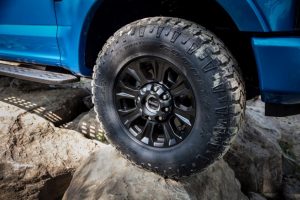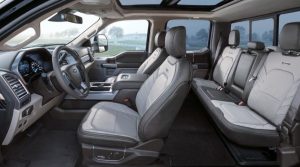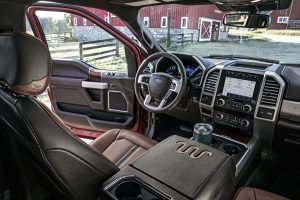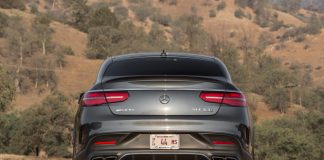It used to be that most trucks came with big V8s, leaf springs and solid axles. If you want such things in a new truck, you’ll want to look at a heavy-duty truck like the Ford F250.
You can’t get this one without a big V8 – and a multi-leaf/solid axle rear suspension with heavy steel coil springs up front, not MacPherson struts are all standard.
It’s also available with a huge – 7.3 liter – V8 that’s also a retro V8 in that it’s not an overhead cam V8 or a direct-injected V8, which makes it unlike the other V8s Ford makes.
It’d look great under the hood of a Mustang, too.
What It Is
The F250 is what a truck used to be – heavy duty in all its variants. Every F250 comes with a big V8 and you can get it with a bigger one – or a diesel one.
It also available with four full-size doors and a full-size (eight-foot) bed and well as with just two doors – and an eight-foot bed – two things becoming unavailable in lighter-duty trucks, which are also becoming more like cars in almost every way except their looks – and their size.
They have compromise suspensions designed for a more car-like ride, which they deliver – at the expense of the ruggedness they’ve lost.
A new F250’s underthings will probably still be intact 30 years from now because heavy cast iron and steel takes a long time to rust away and is very hard to break.
Prices start at $34,230 for the base XL trim regular cab with an eight-foot bed, a 6.2 V8 and rear-wheel-drive. XLT, Lariat, King Ranch, Platinum and Limited trims are also available, with prices topping out at $84,390 for a Limited Crew Cab with 4WD and an eight-foot bed.
Also available, a Tremor package that includes 35-inch off-road knobbies on 18 inch steel wheels, rock-crawl mode, standard 4WD, locking front and rear differentials with water fording tubes for the axles and transfer case and a raised suspension with even heavier duty off-road shocks.
This one also comes standard with the big boss 7.3 liter V8, with the option to buy the 1,050 ft.-lbs.of torque 6.7 liter turbodiesel V8.
It stickers for $53,820 to start.
What’s New
While the lighter-duty F-150 is all-new for 2021, the F250 is largely the same – which will appeal if you want simpler and tougher. It hasn’t got a flat-screen instrument cluster or massaging seats, which are among the features available in the ’21 F-150.
But the biggest V8 you can get in the F150 is only five liters large – and its available diesel isn’t even a V8.
What’s Good
Big truck – big engines – in all trims.
Not much bigger than current half-tons, but much more capable.
Not much more expensive than a half-ton without the big V8.
What’s Not So Good
Regular cab configuration restricted to base XL and XLT trims.
Width of the thing makes some roads feel narrow.
Diesel engine is stupendously (almost $11k) expensive.
Under The Hood
The smallest engine you can get in the F250 is a 6.2 liter V8 that’s as big as the biggest engines available in half-ton trucks. It makes 385 horsepower and 430 ft.-lbs. of torque. This engine is an overhead cam engine, which means it has two cams for each bank of cylinders. It is not, however, direct injected – which fans of simpler-is-better will appreciate. Also fans of not having to worry about carbon fouling of the intake valves, a problem that besets direct-injected engines (which has been “solved” by adding a dedicated port-fuel injection circuit to wash the backsides of the valves down with gasoline, to prevent the carbon from accumulating).
This engine is also paired with a simpler six-speed automatic transmission and can be paired with either 2WD or 4WD.
Optional in all trims is a new 7.3 liter monster V8 that is also a simpler V8. It is an overhead valve V8, with just one cam (and a single chain) actuating the valves, which shouldn’t ever need to be de-carboned because this engine is also not direct-injected.
Another plus is the packaging of this engine. Though bigger than any V8 you can get in anything, it is not a wide V8 – because it is an overhead valve V8. Its cylinder heads do not eat up all the room under the hood, which leaves room to work on it. You can change this engine’s spark plugs/coil packs with a basic $30 socket set and in half an hour, too.
It makes 430 horsepower and 475 ft.-lbs. of torque. The standard transmission with this beast has ten speeds, which isn’t so simple but does give you the benefit of three overdrive gears (vs. the six-speed’s two) as well as tighter gear spacing for the lower gears, which also helps improve fuel economy, no small thing with an engine this big.
The third engine that’s on offer is in-between big in terms of is displacement – 6.7 liters – but mountainous in terms of its torque. It makes 1,050 ft.-lbs., which makes pulling 24,200 pounds conventionally (and 37,0000 pounds with a gooseneck) possible. This engine also makes the most horsepower of three – 475 – and makes it at about half the engine speed (2,500 RPM).
The big drag for this drags-alot engine is the almost $11k the option adds to the tab. Which is probably why Ford offers the 7.3 mountain motor as an option – for just over $2k. It doesn’t pull quite as much as the mighty diesel – but it does pull close. Equipped with the 7.3 V8, an F250 can handle as much as 20,000 lbs.
Without pulling as hard on your wallet.
There used to be an obvious difference when you stepped up – literally – from a 1500 to a 2500 but that has changed because the 1500s are now nearly as big and almost as tall. But there is still a difference in terms of how they drive,which has to do with how they’re built.
As opposed to how they look.
Under the skin, everything the F250 is built on is meatier – and heavier. The cast-iron solid rear axle looks like it could support the weight of a skyscraper; the bundled leaf springs that suspend it from the frame are probably twice as thick as the F-150’s. The frame is worthy of the armor belt of a battleship and those coil springs up front will last the life of the truck.
It’s 1960s tech and bless it for being so. There’s much less to break and what there is is less likely to ever break. It’s not just big engines that endow this truck with the capability to pull the weight-equivalent of four modern cars.
The price you pay for this is the same price a battleship pays for its armor and firepower. It is not as agile as a light-cruiser or destroyer. It needs a few feet more to make a turn-around (about 49 feet for the regular cab with an eight-foot bed; more for Super and Crew cabs, which are longer) and the hydraulic (vs. electric in the 1500) steering is heavier and not as precise. 
But once you’re straightened out, it’s pretty close – in terms of the ride and even of the handling. Its massive proportions aside, it’s not a difficult vehicle to drive except in close quarters maneuvering, as when backing into and out of parking spots sized for cars. Axle hop is available on washboarded gravel and dirt roads, if you seek it out by driving at speeds that make it inevitable. But it hops a lot less if at all than my ’02 Nissan Frontier does at reasonable speeds for gravel and dirt roads.
Lucky for me it snowed during my weeklong test drive of the Tremor version of the F250, which ought to be renamed the Kahuna as it is the king of off-road things when it comes to things this size. A Wrangler Rubicon could probably lose it on a narrow trail but mud and snow aren’t impediments to this monster truck, which has so much ground clearance there’d need to be almost a foot of unplowed snow on the ground before it even reached the running boards.
We only got about four inches, so it wasn’t much of a test – as such – but four inches on Old Poage Road (really) is a test. This road hardly is when it hasn’t snowed. Barely wide enough for one F250 (hopefully another won’t be coming down while I’m coming up) with grades as steep as 13 degrees and fatal drops down the mountain to your unshouldered right. It is a road to be respected and not attempted without the equipment to make it.
Lucky for me the Tremor they sent had the optional Bang and Olufsen premium radio. Because the Trail Control/crawl mode never came into play. This truck is perhaps too capable. Test conditions that would test it would be seriously scary – in the same way that to find out what an Indy car can do, it is necessary to drive it at Indy car speeds and that will whiten your chest hairs, voice of experience speaking.
What’s more impressive is that even with its car-crushing 35-inch knobbies and jacked-up/beefed-up suspension, the Tremor won’t scare you on-road. It is not a beast to drive – though the howl through the air box of the 7.3 liter V8 is the sound you’ll want to unleash as often as space permits.
Here there is a massive difference between this iteration of the Tremor and the F-150 variant, which is powered by Ford’s twin-turbo 3.5 liter V6. It is a mighty engine – 400 horses – but there is no replacement for displacement when it comes to sound. A big truck must have a big V8 to go with it.
Without it, it’s like a cheeseburger without the cheese. 
At The Curb
Dimensionally and visually, there’s not that much difference between an F250 and an F150 Because the F-150 raided the F250’s closet years ago and assumed the “Super Duty” look – including the upcanted profile of the driver’s and passenger side front doors as well as the super-tall bedwalls.
They’re so close, it’s hard to tell them apart unless you check for the gooseneck attachment points in the F250’s bed or look for the Super Duty lettering embossed on the tailgate.
Then it’s easy to tell the difference. The ’21 F250 has a simpler dash layout – analog – and no huge secondary iPad-style touchscreen, as the new F-150’s got. This is arguably a plus, if you like a simpler, more rugged rig with fewer gadgets and most of the controls still controlled by rotating a knob or pushing a button rather than swiping and tapping a screen. It’s true there’s not as much “info” or “tainment” on tap but there is all the necessary info, such as the operating condition of the important accessories (e.g., oil pressure, cooling, volts) which you can toggle through to read what you need.
It’d be nice if the F250 had the folding-flat seats (for sleeping) and the F-150’s available massaging seats but then the F-150 isn’t available with a 7.3 liter V8.
Or with an eight-foot bed and a Crew cab, as the F250 is – with the exception of the Tremor, which isn’t.
You can, however, get a panorama sunroof, power-retractable running boards, power tailgate, power adjustable pedals and that banging Bang & Olufsen audio rig.
But most of all, you can get any engine in any trim – even the base XL trim. Even with a regular cab. The F150 limits the availability of the diesel V6 as well as the twin-turbo V6 (and the new hybrid twin-turbo V6) to the higher trims.
Which brings up an interesting difference.
A small difference.
You can get an XL trimmed F250 with the standard 6.2 V8 and the eight foot bed for just over $34k. The MSRP of an F150 XL regular cab with the optional 5.0 liter V8 is just under $31k.
Pu another way, for about $3k more than what it would cost you to get a half-ton F150 with a small V8 that can’t pull anything close to 20,000 lbs. you could buy a three-quarter-ton F250 with a much bigger V8 that can.
The one thing that’s not heavy metal about the F250 is its body – which is made of aluminum, as the F150’s is. The upside is that aluminum doesn’t rust like steel. The downside is it’s easier to irreparably bend it – and harder to weld it. The heavy-gauge steel that used to be a given for truck panels no longer is – even those that still use steel to make the panels. The thinness is astonishing – as is the amount of cosmetic damage they incur when hit, as by a deer.
It’s very debatable whether the weight (and fuel) saved is worth the cost when damaged – which you pay for even if it isn’t because of what it might cost if it is. Ask your insurance man about this.
The Bottom line
If you’re wanting one like they used to make ’em, they still do.
. . . .
Got a question about cars, Libertarian politics – or anything else? Click on the “ask Eric” link and send ’em in!
If you like what you’ve found here please consider supporting EPautos.
We depend on you to keep the wheels turning!
Our donate button is here.
If you prefer not to use PayPal, our mailing address is:
EPautos
721 Hummingbird Lane SE
Copper Hill, VA 24079
PS: Get an EPautos magnet or sticker or coaster in return for a $20 or more one-time donation or a $10 or more monthly recurring donation. (Please be sure to tell us you want a magnet or sticker or coaster – and also, provide an address, so we know where to mail the thing!)
My eBook about car buying (new and used) is also available for your favorite price – free! Click here. If that fails, email me at [email protected] and I will send you a copy directly!















I’m driving an F-350 Tremor in Platiunum trim and diesel guise. It rides as well as a half-ton pickup of ten years ago.
Two points of correction:
The Tremor does not offer a locking front diff. Only rear.
The Ford Super Duty does have massaging seats on some trim levels, but the setting is buried in the on screen menus.
Agree with everything else completely (note that the Tremor package reduces max tow ratings due to the suspension being off road biased).
2021 F-350 Tremor King Ranch with the 7.3 does have a locking front differential. I have the “base” Tremor King Ranch with the only options of uplifter switches and 5th wheel hitch. I got 12.6 mpg prior to a performance tuner, catback exhaust, and better intake that pumped it up to 14 mpg. The tuner supposedly added 98 HP. I can feel a difference but I am not sure it is that much.
There is a Wipple supercharger kit for about $8 grand that bumps the HP up to 700. I see a lot of stupid actions after adding this kit. Not going to happen for me.
Hi Grit,
Speaking of the 7.3 V8 . . . I used to have a buddy who owned a ’70s refrigerator brown Maverick with a 302 in it. I wish I could go back in time withe a crate 7.3 and see whether we could fit the thing in the Mav…
I’m not a truck fan or a Ford fan but damn, that F250 is sweet as hell. Any engine that comes without that damn direct injection garbage is a winner.
Amen, Pappa!
I wish I could talk Ford into giving me a 7.3 crate engine… for testing purposes…
6.2l is SOHC, not “two cams for each bank of cylinders”.
I didn’t find the place where it said it didn’t have direct injection. I don’t know of a diesel anywhere, powering anything, without direct injection.
Ford has some great exaggerating advertising. There’s one with a 450 pulling a 50′ trailer and the guy is using a camera that just goes all over the place. He got steady enough to show 52,900 lbs on the scales. I noticed the landing gear was sitting on the scales making it sit straight between trailer and truck. I wouldn’t doubt I’m the only one who’s noticed it.
But go ahead and take that load out on I 20. I’ve seen those guys time and time again pulled over in the ditch with a couple DOT rigs doing a lot of writing, eh, uh, typing.
There’s no way you can legal that sort of weight on any state’s road I’m aware of grossing that much weight with a single axle tractor and for that matter, a dual rear axle. But let’s not let reality stick it’s old nasty head in there. Sell those babies to those young guys who finance way too much and find it they’re in for paying off a loan on a used truck while they drive a smaller one with a smaller trailer and find they can’t make any money. This is exactly what happened 20 years ago when all these young guys decided they could get rich using a 350, too long a trailer and waaaayyyy overloaded with mesquite wood.
It ran it’s due pretty fast and all those rigs disappeared to be replaced by old big rigs pulling boxes so it’s not obvious what you’re hauling.
If it wasn’t for the aluminum, it would be just about perfect for a lot of people.